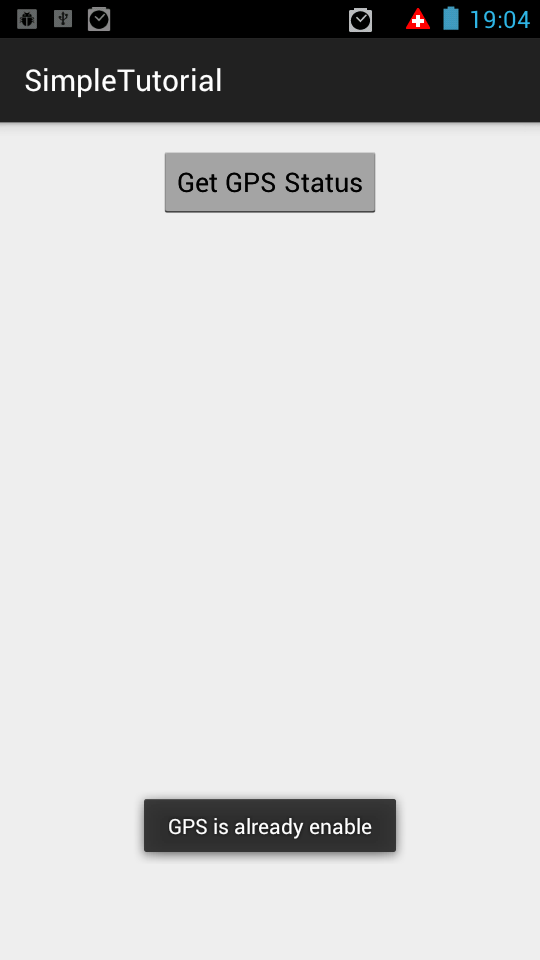To check GPS status and open dialog to set GPS setting
Function:
When the button is pressed, small pop up will be displayed to inform the status of GPS. If GPS is not enable, GPS dialog will be pop up and let user to choose setting. Once the GPS is enable, 'GPS is already enable' will be pop up after the 'Get GPS Status' Button is pressed.
IDE:
Android Studio 1.0.2
Source Code:
The project can be downloaded from here.
Note:
This is the continuous tutorial from here.
Result:
Explanation:
1. As usual, we need to add permission to AndroidManifest.xml
2. Then we need to commit the Fragment in MainActivity.java.
/*way of adding fragment with java*/
//FragmentOne is the class which inflate the fragment_one.xml and return the view
FragmentOne myFragment = new FragmentOne();
FragmentManager manager = getFragmentManager();
FragmentTransaction transaction = manager.beginTransaction();
//'container' is android id in activity_main.xml
//add android:id="@+id/container" in activity_main.xml
transaction.add(R.id.container, myFragment, "main_layout_container");
transaction.commit();
3. In FragmentOne.java, we first setup button to display
//create Button 'button' and link with button id from fragment_one.xml
Button button = (Button) view.findViewById(R.id.button);
4. In FragmentOne.java, we implement OnClickListener to detect the pressing of the button.Also take note that Object of gpsHelperClass is created with Context which will be used in LocationManager.
/*define OnClickListener for button here*/
button.setOnClickListener(new View.OnClickListener() {
//create object and pass context to it.
GpsHelperClass gpsHelperClass = new GpsHelperClass(context);
public void onClick(View v) {
//get boolean result and display small pop up
if (gpsHelperClass.isGpsReadyToUse()) {
Toast.makeText(context, "GPS is already enable",
Toast.LENGTH_SHORT).show();
} else {
Toast.makeText(context, "GPS is not enable",
Toast.LENGTH_SHORT).show();
}
}
});
5. In GpsHelperClass.java, the context passed from FragmentOne.java is first used in constructor.
//at constructor, context is passed from FragmentOne.java and context will be used by GpsHelperClass throughout.
public GpsHelperClass(Context context) {
this.context = context;
}
6. In GpsHelperClass.java, we first setup LocationManger and return the GPS status back. If no GPS is not enable, then we will ask user to enable GPS from the system setting using getUserInputToEnableGPS().
public boolean isGpsReadyToUse() {
//this.context.getSystemService is required if we want to use in separate class
locationManager = (LocationManager) context.getSystemService(Context.LOCATION_SERVICE);
if (!locationManager.isProviderEnabled(LocationManager.GPS_PROVIDER)) {
//We cannot enable GPS via program.
//Still need user input to enable for good reason.
getUserInputToEnableGPS();
}
return locationManager.isProviderEnabled(LocationManager.GPS_PROVIDER);
}
7. In GpsHelperClass.java, we setup alertDialog and start intent to get system location setting if user choose 'alertDialog.setPositiveButton'. Otherwise, we will just cancel the dialog window.
private void getUserInputToEnableGPS() {
//Ref from http://www.androidhive.info/2012/07/android-gps-location-manager-tutorial
AlertDialog.Builder alertDialog = new AlertDialog.Builder(context);
alertDialog.setTitle("GPS is settings");
// Setting Dialog Message
alertDialog.setMessage("GPS is not enabled. Do you want to go to settings menu?");
// On pressing Settings button
alertDialog.setPositiveButton("Settings", new DialogInterface.OnClickListener() {
public void onClick(DialogInterface dialog, int which) {
//Settings.ACTION_LOCATION_SOURCE_SETTINGS == Activity Action: Show settings to allow configuration of current location sources.
// The Settings provider contains global system-level device preferences.
Intent intent = new Intent(Settings.ACTION_LOCATION_SOURCE_SETTINGS);
//Every Activity is invoked by an Intent. therefore, we are going to start activity which allow to set location
context.startActivity(intent);
}
});
// on pressing cancel button
alertDialog.setNegativeButton("Cancel", new DialogInterface.OnClickListener() {
public void onClick(DialogInterface dialog, int which) {
dialog.cancel();
}
});
// Showing Alert Message
alertDialog.show();
}
Complete Code:
Content of MainActivity.java
package com.example.osdevlab.simpletutorial;
import android.app.FragmentManager;
import android.app.FragmentTransaction;
import android.content.Context;
import android.os.Bundle;
import android.support.v7.app.ActionBarActivity;
public class MainActivity extends ActionBarActivity {
public static Context context;
@Override
protected void onCreate(Bundle savedInstanceState) {
super.onCreate(savedInstanceState);
setContentView(R.layout.activity_main); //set to activity_main.xml
/*way of adding fragment with java*/
//FragmentOne is the class which inflate the fragment_one.xml and return the view
FragmentOne myFragment = new FragmentOne();
FragmentManager manager = getFragmentManager();
FragmentTransaction transaction = manager.beginTransaction();
//'container' is android id in activity_main.xml
//add android:id="@+id/container" in activity_main.xml
transaction.add(R.id.container, myFragment, "main_layout_container");
transaction.commit();
}
}
Content of FragmentOne.java
package com.example.osdevlab.simpletutorial;
import android.app.Fragment;
import android.content.Context;
import android.os.Bundle;
import android.view.LayoutInflater;
import android.view.View;
import android.view.ViewGroup;
import android.widget.Button;
import android.widget.Toast;
/**
* Created by osdevlab on 12/29/14.
*/
public class FragmentOne extends Fragment {
Context context;
@Override
public View onCreateView(LayoutInflater inflater, ViewGroup container, Bundle savedInstanceState) {
// Inflate the layout with fragment_one.xml
View view = inflater.inflate(R.layout.fragment_one, container, false);
//create Button 'button' and link with button id from fragment_one.xml
Button button = (Button) view.findViewById(R.id.button);
//returns the Activity the Fragment is currently associated with
//In Fragment, this step requires to pass context to other class.
context = getActivity();
/*define OnClickListener for button here*/
button.setOnClickListener(new View.OnClickListener() {
//create object and pass context to it.
GpsHelperClass gpsHelperClass = new GpsHelperClass(context);
public void onClick(View v) {
//get boolean result and display small pop up
if (gpsHelperClass.isGpsReadyToUse()) {
Toast.makeText(context, "GPS is already enable",
Toast.LENGTH_SHORT).show();
} else {
Toast.makeText(context, "GPS is not enable",
Toast.LENGTH_SHORT).show();
}
}
});
return view;
}
}
Content of GpsHelperClass.java
package com.example.osdevlab.simpletutorial;
import android.content.Context;
import android.location.Location;
import android.location.LocationListener;
import android.location.LocationManager;
import android.os.Bundle;
/**
* Created by osdevlab on 1/1/15.
*/
//we need to first implements LocationListener
//Four functions will be provided by IDE when implements LocationListener and we have to override those functions.
//For now, we don't need to override those functions yet.
public class GpsHelperClass implements LocationListener {
protected LocationManager locationManager;
Context context;
//at constructor, context is passed from FragmentOne.java and context will be used by GpsHelperClass throughout.
public GpsHelperClass(Context context) {
this.context = context;
}
public boolean isGpsReadyToUse() {
//this.context.getSystemService is required if we want to use in separate class
locationManager = (LocationManager) this.context.getSystemService(Context.LOCATION_SERVICE);
return locationManager.isProviderEnabled(LocationManager.GPS_PROVIDER);
}
@Override
public void onLocationChanged(Location location) {
}
@Override
public void onStatusChanged(String provider, int status, Bundle extras) {
}
@Override
public void onProviderEnabled(String provider) {
}
@Override
public void onProviderDisabled(String provider) {
}
}




No comments:
Post a Comment